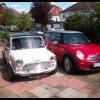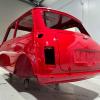"but I'd say here they'd almost certainly be a reversible worm" - wouldn't that require the motor to make torque while stalled? Sure there must be some sort of failsafe that won't impede the manual steering effort.
I don't know a lot about EPS at this time, but I'd say they'd have to have a fail safe for if the fuse blew or some other electrical failure resulting in no assistance. Many of these also seem to be connected to an ECU of sorts to regulate and even drop off the amount of assistance from the EPS, high at low speeds to nil at higher speeds, so surely they must be capable of being reverse driven ?
One issue I do see possibly with many adapted conversions is they all have a torque sensor to detect driver inputs and just how much effort the driver is putting in to the system from the steering wheel. The small bit of info I have read up on, it seems they use a torsion rod in the column and a sensor to measure the difference in angle between the input and output sides of the torsion rod. Clever but effective, though I can't help but feel this may add some sponginess to the feel of the steering ? The other issue is that torsion rod would likely be 'tuned' to a particular torque / effort for the original car they were designed for and may not readily translate from a heavier to a lighter (or viki-verka) set up. I might also be reading / thinking too much in to this too ? I also have some concerns to such a set ups longevity in an off-roading application where there loads of feed back from the wheels and rack ? This is why I felt an old school hydraulic system has high appeal, though far more complex to fit up and not as easily 'tunable' as an electric system might be. The EPS seem to use ball screws which in some ways can fair OK with pounding or can collapse altogether. I've seen first hand how recirculating ball steering boxes fair on rally cars.
Another factor I do like to consider is if it has a serious issue while away is repairing or over-riding it, I feel this is a down side to a hydraulic set up and it would be easy enough to carry a spare standard column for a worse case with EPS.
Much to weigh up !
I can't help reinventing the wheel ![]() . The danger of too little knowledge I guess. Looking forward to being educated - without having to lift a spanner
. The danger of too little knowledge I guess. Looking forward to being educated - without having to lift a spanner ![]()
Strain gauges do need some physical displacement, but they can be on a microscopic scale - the twist across a cm of shaft could be detected by a resistive sensor that goes back & forth across that cm thousands of times. It can sense what we'd sense if the steering column was tens of metres long.
... one side of the system will be the same regardless of the vehicle - the bit with hands & arms will in all likelihood be as good as identical in the anthropometric data they worked to. There's also no mechanical advantage in a steering column if it turns as much at one end as the other so, save for a touch of steering wheel diameter, any power assistance ought to be in the same ball park regardless of rack gearing and anything thereafter.
Even so, I did spot a custom control unit marketed with piccies of a Corsa with a roll-cage. Heavier donor should nudge in the right direction for off-road too. ![]()



















